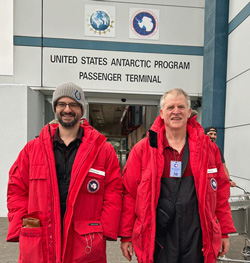Institute for Telecommunication Sciences / About ITS / 2025 / 2025 McMurdo HF Radio Noise Characterization
NTIA Radio Engineers Complete First HF Radio Noise Characterization Study at McMurdo Station, Antarctica, in More Than 25 Years

In December 2024, ITS electronics engineers Robert Achatz and Adam Hicks travelled from ITS’s Boulder laboratory to Antarctica to conduct an important study for the U.S. Antarctic Program (USAP). Every year, McMurdo Station, Antarctica, the largest polar research station in the world plays host to thousands of world-class scientists and auxiliary personnel. These individuals support basic research in many disciplines, including aeronomy and astrophysics, atmospheric chemistry, biology, Earth sciences, ocean and climate systems, glaciology, geospace sciences, geology, and geophysics while they conduct field-based research at or near McMurdo Station or New Zealand’s neighboring Scott Base or Italy’s Mario Zucchelli Station.
What all these experts share is a need for reliable telecommunication systems and the requirement for a radio to be in every tent camp and hut. In and around McMurdo’s harbor, helicopter pad, and some 85 buildings, as well as farther afield on the distant ice, the population stays connected by using a variety of telecommunications devices: satellite phones, VHF radios, and HF radios. For all of these, it is important to keep the radio noise floor as low as possible, especially because Antarctica’s windy and snowy weather conditions can also degrade radio signals. But, since the fail-safe communications choice is HF radio, it’s especially important to ensure clear signals for HF systems.

From a telecommunications standpoint, interference can pose a serious problem, whether on the mainland U.S.A., or at McMurdo Station, Antarctica. Down there, on “the ice”, the frozen crystalline basaltic rock of Ross Island, where McMurdo is located, creates a particularly resistive grounding environment, presenting special challenges for electrical power circuits and systems.
The power sources in use at the NSF’s U.S. Antarctic Program (USAP) McMurdo Station include fossil fuel generators, wind turbines, and solar array systems, and all of them radiate what radio engineers term “man-made noise”, i.e., radio noise that can cause interference to telecommunication systems. And, supporting these are all kinds of electronic devices and pieces of equipment, such as microphones and cables. These also emit noise, and altogether the aggregate noise produces what radio scientists term the “radio noise floor”.
The noise floor has been rising all over the world, including in Antarctica; this is due to the proliferation of ubiquitous always-on wireless devices. For polar researchers using sensitive instruments to detect and record all sorts of scientific data, as well as transmit their findings wirelessly, how can the most effective signal strength be maintained in areas most affected by the increased noise floor? How can McMurdo employees and researchers working on “the ice” be confident that their instruments are working optimally in this brave new world of electronic everything?

Because the last comprehensive HF noise studies at McMurdo were conducted in 1971, followed by a limited effort by the U.S. Navy in 1997, NTIA’s Institute for Telecommunication Sciences (ITS) is assisting the NSF to re-quantify background noise levels in Antarctica. The measurements will help Antarctic spectrum managers ensure that both humans and instruments can communicate where and when they want to.
HF antennas have not changed much over the decades, but, like most electronics, receiver systems have seen significant improvements. It is possible that a differently designed or differently calibrated HF receiver at McMurdo or partner sites could result in less signal interference.
Radio engineers Achatz and Hicks departed November 20, 2024, from the continental United States, where they underwent extensive physical testing and vetting to “Physically Qualify” (PQ) for working in Antarctica. They began their assignment in Christchurch, New Zealand, where they attended safety briefings and received USAP Extreme Cold Weather (ECW) gear before flying to “the ice” on a USAF-operated C-17. They returned to Boulder, Colorado, in mid-December 2024.
ITS supports the USAP in improving spectrum sharing and reducing the probability of harmful electromagnetic interference (EMI) to polar science research programs across the continent—for example, the radio telescopes operating in the Dark Sector at South Pole Station, or the upper atmospheric research conducted in the 70-plus Antarctic Specially Protected Areas (ASPA) designated to minimize human influence to protect sensitive research. Improving spectrum efficiency and bolstering coexistence is a key pillar of the National Spectrum Strategy.
“ITS’s research will positively influence spectrum management on “the ice” and foster improved collaboration and spectrum coexistence that will benefit the cross-disciplinary science being performed in Antarctica,” said ITS Polar Project Manager Sarah Vasel, who has deployed to the frozen continent twice over the past 15 years.

The results of ITS Polar Project Antarctic measurements will be analyzed and published in an ITS Technical Report. An exhaustively detailed actionable report will also be provided to the National Science Foundation (NSF), which manages the USAP.




